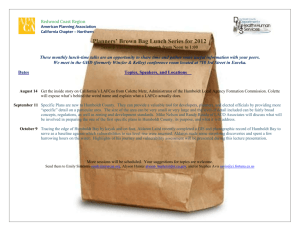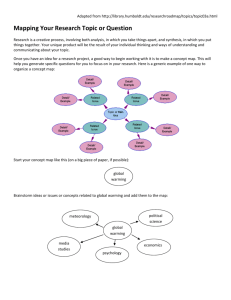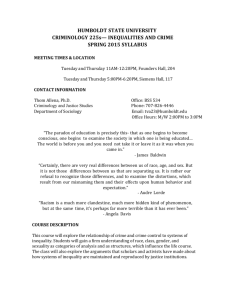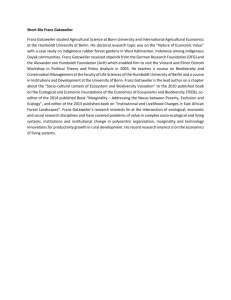File
advertisement
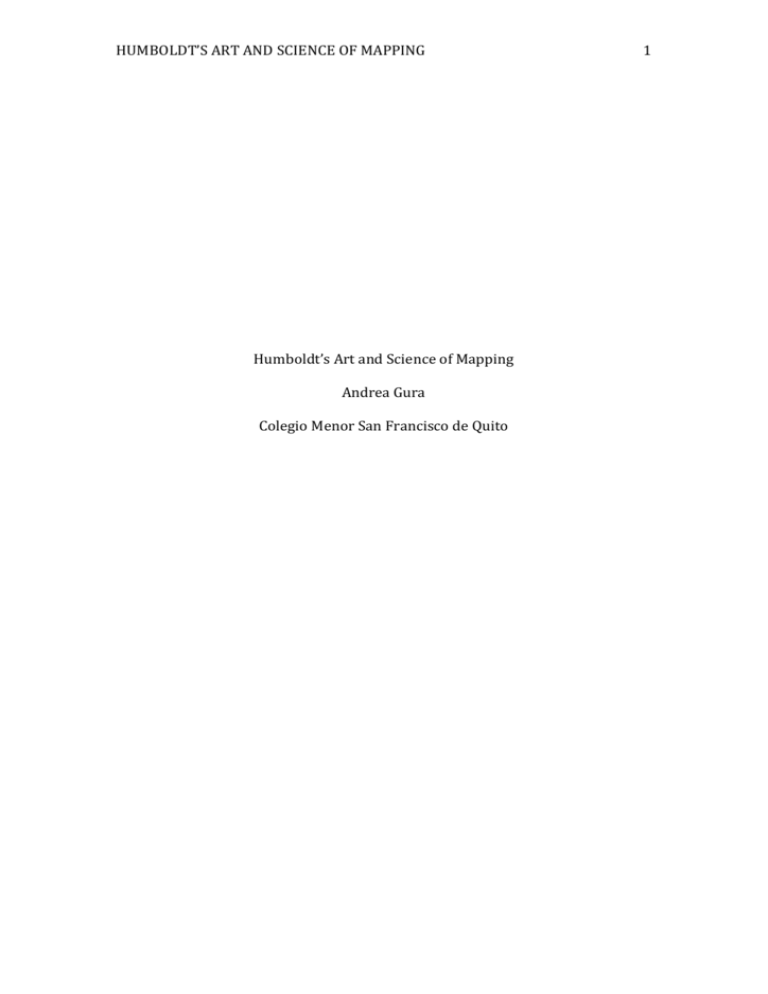
HUMBOLDT’S ART AND SCIENCE OF MAPPING Humboldt’s Art and Science of Mapping Andrea Gura Colegio Menor San Francisco de Quito 1 HUMBOLDT’S ART AND SCIENCE OF MAPPING 2 Humboldt’s Art and Science of Mapping “A diagrammatic representation of an area of land or sea showing physical features, cities, roads, etc. “ is Oxford’s dictionary’s definition for a map. Alexander von Humboldt, a European scientist set on a voyage to the Americas along Venezuela, Colombia, Ecuador, Mexico and the United States in the 1800’s. Here, he expanded humanity’s prior knowledge on mineralogy, chemistry, botany, climatology, cartography, isotherms, etc. Humboldt mapped the data he investigated here, something previously unseen within his profession since he used branches of biology to guide a person around a landscape. Future generations didn’t use Alexander’s map designs again, but much was learned from how he gathered and presented information, the way he studied nature and how he formulated theories. Humboldt’s studies of the Andes were indispensable to history since it guided scientific studies yet to come and his actions and strategies became what the science world learned from in the future. His hike up the Chimborazo mountain in the Ecuadorian Andes gave him much fame. The journey he took started at sea level in the city of Guayaquil, and from there he climbed all the way up to the mountain’s glacier covered peaks while, together would other scientists, on a methodical basis, would stop and gather plant samples, record the altitude these grew in, measure the gasses’ pressure, etc. According to the guide Felipe, “His ascend would look something like this: first before any other plant life would be the mangroves, then the humid tropical forest followed by the cloud forest, the high cloud forest, the moors, the desert-like and agriculturally/florally “dead” zone, and finally the snow covered top.” Afterwards, Alexander created a map where someone could HUMBOLDT’S ART AND SCIENCE OF MAPPING 3 locate themselves according to the region’s vegetation, and could immediately know a lot about the area as far as flora, fauna, climate, air pressure, altitude, etc. Another thing Humboldt did with a great deal of frequency was to compare what he found in the Andes, to Europe. The reason why he did this was most likely because of the remarkable differences between the two continents, for instance how in Ecuador, a lush cloud forest would be found where at the same altitude in Europe, one would find themselves beyond the tree line. Because there were no cameras at the time, Humboldt himself drew and painted Chimborazo with its respective vegetation sections with extreme artistic detail. Right next to Chimborazo’s illustration Cotopaxi’s drawing (another volcano he partially climbed), a label of where Mont Blanc (Europe’s tallest mountain) would reach, and in the margins were charts explaining the scientific details of each plantaltitude sector. In consequence of his return, he published “The Essay on the Geography of Plants“, and presented smaller articles translated in languages such as French, German and Latin in the French Academy, Germany, and London. It is clear to see how distinctive Humboldt’s studying techniques were when these are analyzed. He correlated botany, geology, geography, climatology and many more sciences with maps. No one before had found a way to include sciences other than topography or geography in maps. It was thanks to him that future generations of scientists came to study Andean nature. Since he showed off south America hyper realistically often in Europe, a wave of scientists came along after him to the new continent. In Eugene McCarthy’s words: “Late in life, Charles Darwin said von Humboldt’s Narrative had been the primary inspiration for his own decision to ship on board the Beagle and sail around the world.” The world can ask themselves thanks to this quote; What would have been of science HUMBOLDT’S ART AND SCIENCE OF MAPPING 4 today if Humboldt hadn’t invited more scientists to come and study America? The rest of the discoveries made later on wouldn’t have existed, there would have been a gap of information in the timeline of science that may or may not have been uncovered in the future. Darwin’s theory of evolution would have never existed. Every “era“ of scientific studies is chained with the one that came before it and with that one that will come after, so in this way, all of the discoveries made in “Humboldt’s era” and on would never been the same. Humboldt’s strategies relative to theorization were very well rounded. He believed that “no organism or phenomena could be fully understood in isolation. Living things, the objects of biological study had to be considered in conjunction with data from other fields of research.” (Anne Buttimer, 2012). In other words, he believed that before one could formulate conclusions, every scientific perspective about it had to be comprehended. This is reflected in his own study habits. He was an expert in numerous sciences. Once again, future scientists studied these habits as well. They might not have had Humboldt’s mentality of having to know all the branches of science to be a scientist, however the ability to perfect, agree, modify or disprove concepts and ideas was reinforced. More modern scientists (equipped with technologically better tools) had to look at Humboldt’s work and publishings, and the task of distinguishing what could and could not be believed led to the eradication, acceptance or modification of Humboldt’s principles. Concepts with more scientifically specific content than what Humboldt did were created. Furthermore, what Humboldt found in 1802 as far as vegetation is different to what is found today at the same altitude. In this way, his studies work as a register of what there was before, since many plants have had their names changed or have disappeared. He is HUMBOLDT’S ART AND SCIENCE OF MAPPING 5 known to be ecology’s forefather, and even though much of what he has said has been disproven, he put assembled the skeleton of science that was broken, repaired and built on top of. So all in all, it is safe to say that Alexander really did set the base for much of science. His work gave start to many new studies besides his own, and even though his methods of drawing science on a map is no longer used, all his research and work has definitely contributed to what the world knows about science today, only that his modified or perfected theories are presented in forms other than maps. Undeniably, Alexander von Humboldt opened eyes to many generations of future scientists by showing humanity how studying nature should be done, how an expedition or how the process of gathering information should happen, and how one must come to conclusions properly. HUMBOLDT’S ART AND SCIENCE OF MAPPING 6 References Buttimer, A. (2012, March)« Alexander von Humboldt and planet earth’s green mantle », Cybergeo : European Journal of Geography Histoire de la Géographie, Didactique, document 616. Retrieved March 2, 2015 from http://cybergeo.revues.org/25478 ; DOI : 10.4000/cybergeo.25478 Guide Felipe, personal communication, February 25, 2015 McCarthy, E. (n.d.). Alexander von Humboldt - Biography. Retrieved March 17, 2015, from http://www.macroevolution.net/alexander-vonhumboldt.html#.VQiwnBDF8mU Oxford Dictionaries - Dictionary, Thesaurus, & Grammar. (n.d.). Retrieved March 11, 2015, from http://www.oxforddictionaries.com/ Peter, J. (2002, October 4). Climb Chimborazo and See the World. Retrieved March 2, 2015, from http://www.sciencemag.org/content/298/5591/63 Ziegler, J. (1864, January 1). Old Maps, Expeditions and Explorations. Retrieved March 2, 2015, from http://mitchtestone.blogspot.com/2011/03/humboldt-andritter.html HUMBOLDT’S ART AND SCIENCE OF MAPPING 7
